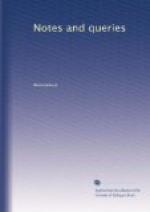The author adds,—
“The soldiers were next day publicly thanked by a letter from the Secretary-at-War in his master’s name. McLaughlin, who actually killed the inoffensive Allen, was withdrawn from justice and could never be found, so that though his two associates Donald Maclaine and Donald Maclaury, with their commanding officer Alexander Murray, were proceeded against for the murder, the prosecution came to nothing and only contributed to heighten the general discontent.”
With respect to the monument in St. Mary’s, Newington, I extract the following from the Oxford Magazine for 1769, p. 39.:—
“Tuesday, July 25. A fine large marble tombstone, elegantly finished, was erected over the grave of Mr. Allen, junr., in the church-yard of St. Mary, Newington, Surry. It had been placed twice before, but taken away on some disputed points. On the sides are the following inscriptions:—
North Side.
Sacred to the Memory of
William Allen,
An Englishman of unspotted
life and amiable disposition, [who was
inhumanely murdered near St.
George’s Fields, the 10th day of May,
1768, by the Scottish detachment
from the army.][1]
“His disconsolate parents,
inhabitants of this parish, caused this
tomb to be erected to an only
son, lost to them and the world, in his
twentieth year, as a monument
of his virtues and their affections.”
At page 53. of the same volume is a copperplate representing the tomb. On one side appears a soldier leaning on his musket. On his cap is inscribed “3rd Regt.;” his right hand points to the tomb; and a label proceeding from his mouth represents him saying, “I have obtained a pension of a shilling a day only for putting an end to thy days.” At the foot of the tomb is represented a large thistle, from the centre of which proceeds the words, “Murder screened and rewarded.”
Accompanying this print are, among other remarks, the following:—
“It was generally believed that he was m——d by one Maclane, a Scottish soldier of the 3d Regt. The father prosecuted, Ad——n undertook the defence of the soldier. The solicitor of the Treasury, Mr. Nuthall, the deputy-solicitor, Mr. Francis, and Mr. Barlow of the Crown Office, attended the trial, and it is said, paid the whole expence for the prisoner out of the Treasury, to the amount




